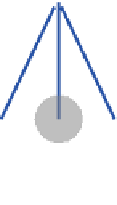Java Reference
In-Depth Information
root node
leaf nodes
FIGURE 13.8
A tree data structure
Graphs
Like a tree, a
graph
is a non-linear data structure. Unlike a tree, a
graph does not have a primary entry point like the tree's root node.
In a graph, a node is linked to another node by a connection called
an
edge
. Generally there are no restrictions on the number of edges
that can be made between nodes in a graph. Figure 13.9 presents a
graph data structure.
Graphs are useful when representing relationships for which linear paths and
strict hierarchies do not suffice. For instance, the highway system connecting cit-
ies on a map and airline connections between airports are better represented as
graphs than by any other data structure discussed so far.
In a general graph, the edges are bi-directional, meaning that the edge con-
necting nodes A and B can be followed from A to B and also from B to A. In a
directed graph
, or
digraph
, each edge has a specific direction. Figure 13.10 shows
a digraph, in which each edge indicates the direction using an arrowhead.
A digraph might be used, for instance, to represent airline flights between
airports. Unlike highway systems, which are in almost all cases bi-directional,
having a flight from one city to another does not necessarily mean there is a
KEY CONCEPT
A graph is a non-linear data structure
that connects nodes using generic
edges.























Search WWH ::

Custom Search